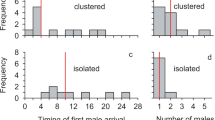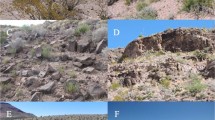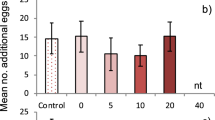Abstract
PRONOUNCED differences in mating success between males holding territories clustered on traditional mating grounds (leks) are commonly cited as evidence of female choice for male phenotypes1–6but female ungulates appear to prefer particular territories6–12 even when no other individuals are on the lek11,12. Female choice of territories may be influenced by spatial features7–10,12,but observations suggest that females may also be attracted to successful territories by olfactory cues in the soil13. Here we report that transferring the topsoil between successful and unsuccessful territories on leks of two reduncine antelope species caused the numbers of females and matings on the unsuccessful territories to increase tenfold. Females were probably attracted to the soil by smells that had accumulated from heavy use by other females. Because of this attraction, stochastic process may play an important part in generating the variance in mating success between territory holders on leks.
This is a preview of subscription content, access via your institution
Access options
Subscribe to this journal
Receive 51 print issues and online access
$199.00 per year
only $3.90 per issue
Buy this article
- Purchase on Springer Link
- Instant access to full article PDF
Prices may be subject to local taxes which are calculated during checkout
Similar content being viewed by others
References
Alexander, R. D. in Insects, Science and Society (ed. Pimental, D.) 35–77 (Academic, New York, 1975).
Bradbury, J. W. & Gibson, R. in Mate Choice (ed, Bateson, P.) 109–138 (Cambridge Univ. Press, 1983).
Clutton-Brock, T. H., Hiraiwa-Hasegawa, M. & Robertson, A. Nature 340, 463–465 (1989).
Höglund, J., Eriksson, M. & Lindell, L. E. Anim Behav. 40, 23–32 (1990).
Kirkpatrick, M. & Ryan, M. J. Nature 350, 33–38 (1991).
Balmford, A. P. Trends Ecol. Evol. 6, 87–92 (1991).
Buechner, H. K. & Schloeth, R. Z. Tierpsychol. 22, 209–225 (1965).
Floody, O. R. & Arnold, A. P. Z. Tierpsychol. 37, 192–212 (1975).
Fryxell, J. M. Ethology 75, 211–220 (1987).
Apollonio, M., Festa-Bianchet, M., Mari, F. & Riva, M. Anim. Behav. 39, 205–212 (1990).
Gosling, L. M. & Petrie, M. Anim. Behav. 40, 272–287 (1990).
Deutsch, J. C. & Weeks, P. Behav. Ecol. (in the press).
Modha, K. L. thesis, Makerere Univ. Kampala (1973).
Buechner, H. K. Science 133, 698–699 (1961).
Schuster, R. H. Science 192, 1240–1242 (1976).
Baimford, A. P. thesis, Cambridge Univ. (1990).
Gosling, L. M. Anim Behav 35, 620–622 (1987).
Leuthold, W. Behaviour 27, 215–257 (1966).
Lasley, B. L. Adv. vet. Sci. comp. Med. 30, 209–228 (1985).
Hindle, J. E. & Hodges, J. K. J. reprod. Fert. 90, 571–580 (1990).
Hogan-Warburg, A. J. Ardea 54, 111–229 (1966).
Clutton-Brock, T. H., Green, D., Hiraiwa-Hawgawa, M. & Albon, S. D. Behavl Ecol. Sociobiol. 23, 281–296 (1988).
McDonald, D. B. Anim. Behav. 37, 1007–1022 (1989).
Höglund, J., Alatalo, R. V. & Lundberg, A. Behaviour 114, 221–231 (1990).
Gibson, R. M., Bradbury, J. W. & Vehrencamp, S. L. Behavl Ecol. 2, 165–180 (1991).
Bradbury, J. W., Vehrencamp, S. L. & Gibson, R. in Evolution: Essays in Honour of John Maynard Smith (eds Greenwood, P. J., Harvey, P. H. & Slatkin, M.) 301–314 (Cambridge Univ. Press, 1985).
Wade, M. J. & Pruett-Jones, S. G. Proc. Natn. Acad. Sci. U.S.A. 87, 5749–5753 (1990).
Author information
Authors and Affiliations
Rights and permissions
About this article
Cite this article
Deutsch, J., Nefdt, R. Olfactory cues influence female choice in two lek-breeding antelopes. Nature 356, 596–598 (1992). https://doi.org/10.1038/356596a0
Received:
Accepted:
Issue Date:
DOI: https://doi.org/10.1038/356596a0
This article is cited by
-
Variability in temporary emigration rates of individually marked female Weddell seals prior to first reproduction
Oecologia (2013)
-
Do great tits rely on inadvertent social information from blue tits? A habitat selection experiment
Behavioral Ecology and Sociobiology (2008)
-
Uganda kob mating success does not increase on larger leks
Behavioral Ecology and Sociobiology (1994)
Comments
By submitting a comment you agree to abide by our Terms and Community Guidelines. If you find something abusive or that does not comply with our terms or guidelines please flag it as inappropriate.



